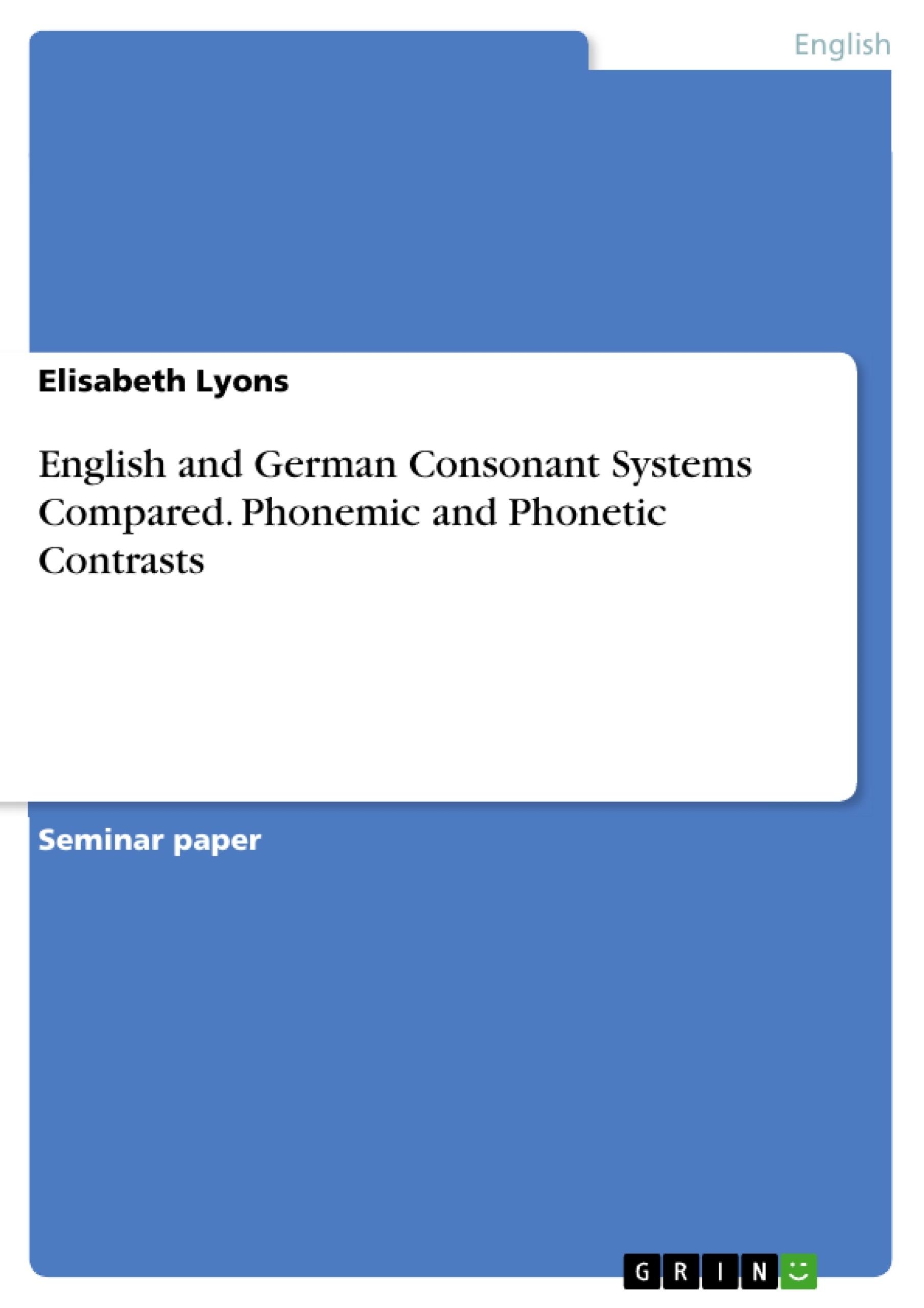Excerpt
Table of Contents
1. Introduction
2. Classification of consonants
3. Plosives
3.1. Final devoicing
3.2. Aspiration
3.3 Glottalisation
4. Nasals
5. Fricatives
5.1. Dental fricatives
5.2. Dorsal fricatives
5.3. Post-alveolar fricatives
5.4. Final devoicing
6. Affricates
7. Lateral
8. R-Variants
8.1. English variants
8.2. German variants
9. Glides
10. Conclusion
List of abbreviations
Abbildung in dieser Leseprobe nicht enthalten
1. Introduction
This paper aims to show the most important consonant-related differences between English and German. Not only are phonemic features compared, it also deals with the phonetic differences of consonants that are phonologically identical. The comparison also briefly looks at eventual difficulties in pronunciation of unfamiliar sounds for the learner of the respective language.
The consonants are grouped according to the parameter manner of articulation, and each group, i. e. plosives, nasals, fricatives, affricates, laterals, R-variants and glides, is compared in a separate chapter. Additionally to the distinctive sounds, the most important allophonic variants of certain phonemes of both languages are looked at.
The differences described in this comparison do not claim to be exhaustive, however the paper aims to give a general overview regarding the most predominant differences and similarities of the English and German consonant systems, phonologically as well as phonetically. Unless stated differently, the English referred to is RP.
2. Classification of consonants
To describe consonants in phonetics and phonology, the following three parameters are generally used:
- place of articulation
- manner of articulation and
- voicing.
The English and German consonant systems are similarly structured and contain a number of phonemes that share the same description. According to Gimson (1989, 150) , English has “twenty-four distinctive units which are consonantal both in terms of their function [...] and also, in the majority of cases, in terms of their phonetic nature [...]”. German as well has 24 phonemes in its consonant inventory (König/Gast 2007, 14). Not all of the English and German consonants are phonologically identical, but they do overlap to a certain extent. English has six plosives, nine fricatives, two affricates, three nasals, two glides and two liquids comprising /r/. German has six plosives, ten fricatives, four affricates, three nasals, one glide and also two liquids including /r/, which is realised in different ways.
3. Plosives
English and German share the same set of plosives, which is also fully symmetric regarding voicing:
Abbildung in dieser Leseprobe nicht enthalten
Table 1: The plosives of English and German
These plosives show the same phonological features, but there are still some differences when it comes to their concrete realisation. Below, the most important non-phonemic contrasts regarding plosives are described.
3.1. Final devoicing
Final devoicing in German refers to the fact that voiced obstruents are devoiced at the end of a syllable, thus plosives - being obstruents - are concerned by that phonetic rule of Standard German. In English, this process does not exist. Due to final devoicing the voiced plosives [b], [d] and [g] do not occur in final position - even though orthography may suggest it - as the following comparison shows (Keutsch 1974, 39):
Abbildung in dieser Leseprobe nicht enthalten
3.2. Aspiration
Syllable-initially, voiceless plosives /p/, /t/ and /k/ are generally aspirated in both English and German, with the aspiration being stronger in stressed syllables. Gimson (1989, 152) explains aspiration as “voiceless interval consisting of strongly expelled breath between the release of the plosive and the onset of a following vowel”. For example, there is clear aspiration in the words pan [ph^n] in English and Panne [phana] in German. In non-initial positions the voiceless plosives are generally unaspirated. The following examples show the difference:
Abbildung in dieser Leseprobe nicht enthalten
In word-final positions, the aspiration is generally stronger in German than in English. In English, as described by Gimson (1989, 153), /p/, /t/ and /k/ can have no audible release in final position. Examples for that process are the pronunciation for the German word Hut [hu:th] and the English word hat [hst]. In German, a plosive may only be unreleased when followed by another consonant but never word-finally.
3.3 Glottalisation
In English, unreleased final plosives are often glottalised, which means that there is an additional closure of the glottis. Gimson (1989, 159) calls it also glottal reinforcement and states that voiceless plosives in final position “have the oral closure reinforced by a glottal closure [?]”. Since the glottal stop [?] is not distinctive, it is not a phoneme. However, it occurs in many types of British English. For example, the word but can be realised as follows:
Abbildung in dieser Leseprobe nicht enthalten
4. Nasals
The English and German consonant inventories both have the same three nasals:
Abbildung in dieser Leseprobe nicht enthalten
Table 2: The nasals of English and German
Nasals are sonorants hence always voiced. Phonologically they share the same features. However, there are some phonetic differences regarding the realisation of the velar nasal /g/.
The /g/ sound occurs only after vowels in both English and German and never word-initially. In English, [g] occurs at the end of a morpheme and in morphologically complex words, e.g. in sing [sig] and singing [sigig]. In German it is found word-finally too, but also before the schwa-sound, e.g. Gang [gag], Finger [fign].
Furthermore, [g] is inserted in English - resulting in [gg], when [g] is found morpheme-internally, as well as in comparative and superlative forms, such as e.g. in finger [figga] or longer [lngga]. In German, [g] is added before vowels other than schwa, as for example in Bingo [biggo].
[...]
- Quote paper
- Elisabeth Lyons (Author), 2013, English and German Consonant Systems Compared. Phonemic and Phonetic Contrasts, Munich, GRIN Verlag, https://www.grin.com/document/496677
Publish now - it's free






















Comments